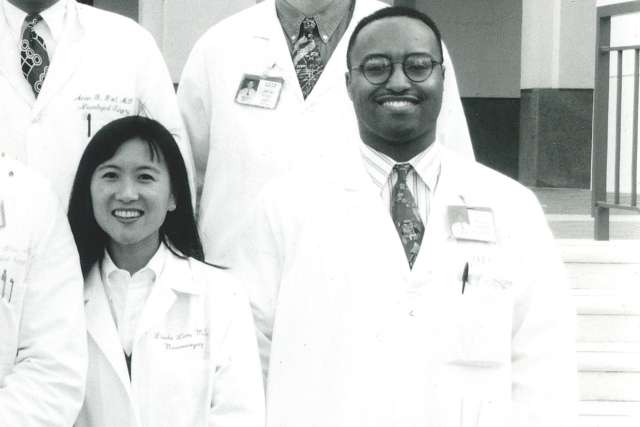For UCLA neurosurgeons Linda Liau, MD, PhD, and Langston Holly, MD, their years together as residents at UCLA Medical Center seem like a lifetime ago.
It has been nearly 25 years since they graduated the neurosurgery residency program. Dr. Liau was the only woman in the program, and Dr. Holly was the only Black resident. But they both remember it like it was yesterday.
"I was very impressed by her ability to multitask," Dr. Holly said of his colleague and friend who is now chair of the Department of Neurosurgery at the David Geffen School of Medicine at UCLA. Dr. Holly is executive vice chair and also serves as co-director of the UCLA Spine Center in Santa Monica where he performs spine as well as brain surgeries.
"It seemed like she was in multiple places at once – the operating room, the emergency room and on the wards. This is a quality that she still has to this day, as she balances a large number of responsibilities both here in our department and nationally in organized neurosurgery."
Dr. Liau remembers Dr. Holly's "great attitude and wonderful sense of humor."
"He often made everyone laugh with his jokes," she said, adding that they have been kindred spirits, helping and inspiring each other, often through tough times. "We went through many challenges during our residency and our early faculty years … challenges I hope current and future women or people of color in neurosurgery would never have to face."
But, going through those experiences together has helped them shape their common goals of trying to make things better not just for their department and for UCLA, but also for their entire profession.
Both certainly beat the odds in their chosen field, which has been dominated by white men. Fewer than 4% of all neurosurgeons in the United States are Black. Women make up more than half of graduating medical classes each year and yet, only 6% of board-certified practicing neurosurgeons are women.
The fissures of inequity run deeper at the intersection of gender and race. Black women make up just 0.6% of the neurosurgical workforce in the country. Neurosurgeons of other gender identities and racial groups are so poorly represented in the field that their numbers remain unknown.
Yet Drs. Liau and Holly have illuminated a path forward for others from similar backgrounds. They have guided and mentored aspiring neurosurgeons while sparking and continuing critical conversations about diversity, equity and inclusion in this field.
Breaking the gender barrier
Dr. Liau was an infant when her parents emigrated to the U.S. from Taiwan. They moved from Ohio to Los Angeles when she was 5. Her father worked odd jobs while her mother labored as a seamstress in sweatshops downtown. A gifted student, Dr. Liau got her break when she was selected to attend a college-prep high school in Cerritos. Her academic journey took her to Brown University, Stanford Medical School and eventually UCLA.
Her love for neuroscience began in medical school at Stanford. However, what really inspired Liau was a meeting in her third year with Dr. Frances Conley, who in 1977 was the fifth woman to become a board-certified neurosurgeon in the United States. She was also the first woman in the country to be granted a tenured professorship in neurosurgery.
"She was one of my first role models in this field," Dr. Liau said. "She was a such an inspiration."
But three decades ago, the road to becoming a neurosurgeon proved daunting for Dr. Liau. Initially, her gender -- not race -- turned out to be the more formidable obstacle, she said. As she attended interviews for residency, she was told "women should not be in this field."
"There was one very well-known department chair who shook my hand and said I was a lovely young lady, but wasn't the right fit," Dr. Liau recalled. "In several instances, I was asked if I planned to have children. I was told I couldn't do both."
Dr. Liau said she overcame those heartbreaks by teaching herself how to respond to rejection and outright discrimination.
"I realized that I couldn't change people's assumptions, beliefs or first impressions," she said. "But, I could change how I reacted to that. The problem was not with me. It was with them. Every time someone said I couldn't do it, I responded with: I'm going to show them."
Dr. Liau said she worked extra hard and sometimes even overcompensated to counter people's judgments and assumptions.
"In retrospect, it shouldn't have been that way," she said. "I shouldn't have had to work harder than my white, male peers."
Her many accomplishments bear testimony to her perseverance.
Dr. Liau is the first woman to chair the American Board of Neurological Surgery. She is the first woman president of the Western Neurological Society, and one of only a handful of neurosurgeons elected to the National Academy of Medicine. She is also the second woman to chair a neurosurgery department in the United States.
Shattering racial barriers
Just as Dr. Liau was inspired by her mother, Dr. Holly derived inspiration and immense hope from his father, Dr. John Holly. He was born and raised in Alabama — in the segregated south — and yet, against all odds, became a neurosurgeon.
"If you were Black, and in the South, you were only allowed to go to Historically Black Colleges and Universities, or HBCUs," Dr. Holly said.
His father was drafted to go to Vietnam and spent a year in Saigon as a physician. There, he learned how to do brain surgery from a white neurosurgeon in the military. Thanks to a recommendation from that doctor, Dr. John Holly was able to get into the neurosurgery residency program at the University of Missouri when he returned stateside. After graduating residency, he moved to California where he worked as a private practice neurosurgeon in the underserved communities of South Central and East Los Angeles for four decades.
"That changed the trajectory of our whole family," said Dr. Holly. "But it took something of that magnitude for a generational shift to occur. Seeing that my dad did it in spite of all the limitations he had because of his race, gave me hope that I could do it."
It also taught him another important lesson.
"My father's story showed me that even when you are in the middle of a catastrophic war there are silver linings and blessings you can get individually," he said. "Had my father not been there and not worked that hard, there is no way this other doctor would have seen his potential. You have to be prepared for your moment and never lose faith and hope."
Dr. Langston Holly enjoyed learning about the brain and the central nervous system at a young age. During his residency, he was fascinated not just by innovations in surgery, but also meeting patients and hearing their stories. However, he encountered a completely different set of challenges than his father.
"When I was in school, I would be the only person who looked like me," he said. "One of the biggest challenges for me the whole way was not seeing others who were Black."
He also encountered discrimination and situations where "people's behavior and their interactions" indicated that neurosurgery was no place for a person of color.
"I learned early on not to pay attention to that," Dr. Holly said. "That had to do with their own biases and it had nothing to do with me. When I looked at what my father had to go through, my course was a lot more straightforward. It still wasn't easy."
Dr. Holly is currently a director of the American Board of Neurological Surgery. He is one of the only Black directors in the history of the board. He is the first Black president of the California Association of Neurological Surgery. He is a past chair of the Neurology/Neurosurgery section of the National Medical Association.
Increasing diversity in neurosurgery
Neurosurgery is a unique field that requires significant training and expertise, and the lack of diversity has been one of the field's biggest limitations, Dr. Holly said.
It remains a major challenge today because there are fewer Black male candidates applying and going to medical school now compared to when he was in college, he said.
"So, although people's attitudes and their ability to welcome diverse student populations have improved, we still see a lack in numbers," Dr. Holly said. "The best way forward is to increase the diversity of trainees and faculty."
Dr. Liau also believes the solution to the diversity problem in neurosurgery is to place more women and people of color in leadership positions.
"It's key to opening doors and pulling people up," she said. "Oftentimes, when leaders themselves are individuals who have not worked with those from diverse backgrounds, that's where the stereotypes creep in. Diversity and inclusion make for a better organization."
As a leader herself, Dr. Liau knows the difference that mentoring and promoting people from diverse backgrounds has made at UCLA. Only 10 years ago, none of the department's 21 residents were women or people of color. The change began to happen when there was an intentional effort to be diverse and inclusive, she said.
"We realized it was not just enough to look at the pool of applicants we had," she said. "We made a bigger effort to reach out to a diverse group of applicants. You need a critical mass to change the culture of the program."
Now, 43% of the residents in the neurosurgery department are women.
Dr. Holly spends a lot of time mentoring Black students at all levels -- high school, college and medical school. He has counseled students who struggle with situations where they feel they have been mistreated or are not getting the respect they deserve.
Increasing the number of trainees and faculty in neurosurgery from underrepresented groups is important not just for diversifying the field, but also to make sure care is equitable, Dr. Holly said.
"Often, patients from underrepresented backgrounds are more comfortable seeing physicians who look like them," he said. "Augmenting the number of physicians from these groups helps because the doctors are also comfortable being engaged in these communities."
Just as she was inspired by Dr. Conley, Dr. Liau believes women will be encouraged to pursue a career in neurosurgery when they see more role models.
"One thing that discourages women is the fear that they won't be able to have a family," she said. "I have two children. When you see others who look like you accomplishing what you aspire to achieve, that is a very powerful thing."





